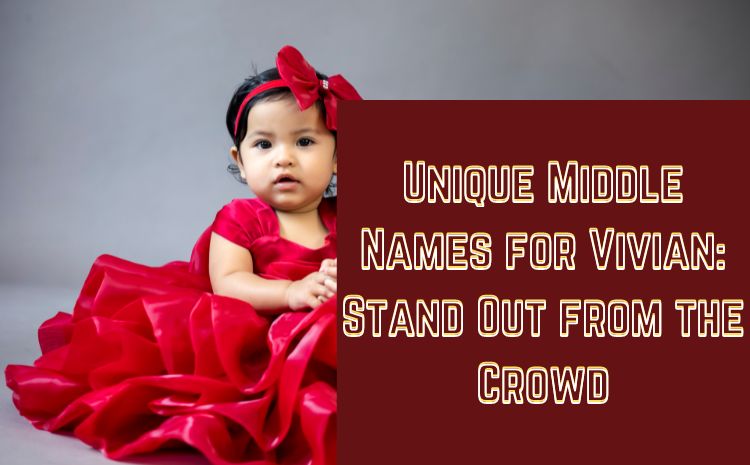100 Unique Middle Names for Vivian: Stand Out from the Crowd

Hi there! Choosing middle names for Vivian? how delightful! We will embark on this joyful journey together and explore some unique girl names that complement Vivian’s beautiful name.
First and foremost, Vivian is a beautiful name with charm and elegance. When search for middle names for Vivian – we want a middle name that resonates with grace and sophistication, don’t we?
Remember, this process is meant to be filled with warmth and affection. Trust your heart, and let it guide you to the perfect middle name for Vivian, one that sings to your soul and resonates with love.
Wow! what a delightful name. I hope you choose Vivian for your girl when picking a name idea for your baby.
Now! Get our awesome back to school supplies for your child and little angles, Enjoy high discount rate today!
| Name | Vivian |
| Origin | Latin |
| Meaning | Alive, Lively |
| Gender | Female |
| Pronunciation | viv-ee-in |
| Popularity | 103 |
| Middle Names | Vivian Rose, Vivian Grace, Vivian Deb |
| Nicknames | Viv, Vivi, Vi-love, Vi-boo |
Table of Contents
The Meaning of Vivian
Friends, I know you are curious about the Vivian and wants to know the meaning. Well lets deviate A bit! Vivian is a girl name with lovely, elegant sound to it.
Names can hold so much significance, and understanding their origins can give us a deeper appreciation for their beauty.
Now, let’s take on a little journey to explore the meaning of Vivian. It is a delightful name with rich history and derived it origin from the Latin word “vivus,” which means “alive” or “lively.” Vivian reflects a vibrant and vivacious spirit, a zest for life that can light up any room.
With many nicknames like Vivi, Vivian is seen as a name for individuals who radiate charm, intelligence, and creativity. People with this name are often described as captivating and inspiring, with an infectious enthusiasm that uplifts those around them. They have an innate ability to connect with others and bring joy to every interaction.
Read Also: 100 Best Middle Names for Genesis
Unique Middle Names for Vivian
- Vivian Maeve
- Vivian Aurelia
- Vivian Isla
- Vivian Eloise
- Vivian Luna
- Vivian Alice
- Vivian Aurora
- Vivian Ophelia
- Vivian Evangeline
- Vivian Iris
- Vivian Violet
- Vivian Daphne
- Vivian Matilda
- Vivian Freya
- Vivian Cora
- Vivian Josephine
- Vivian Eleanor
- Vivian Phoebe
- Vivian Clara
- Vivian Elowen
- Vivian Florence
- Vivian Arabella
- Vivian Elise
- Vivian Camille
- Vivian Serenity
- Vivian Gabrielle
- Vivian Rosalie
- Vivian Emilia
- Vivian Penelope
- Vivian Aurora
- Vivian Evangeline
- Vivian Anastasia
- Vivian Serenade
- Vivian Imogen
- Vivian Lillian
- Vivian Noelle
- Vivian Felicity
- Vivian Autumn
- Vivian Clementine
- Vivian Estelle
- Vivian Serene
- Vivian Gwendolyn
- Vivian Pearl
- Vivian Josephine
- Vivian Rosalind
- Vivian Serenity
- Vivian Celestina
- Vivian Coraline
- Vivian Snow
- Vivian Kalilah
- Vivian Madrigal
- Vivian Nixi
- Vivian Delphi
- Vivian Tamsin
- Vivian Blue
- Vivian Romilly
- Vivian Cosima
- Vivian Prairie
- Vivian Sunniva
- Vivian Izara
- Vivian Pandora
- Vivian Lavender
- Vivian Pallas
- Vivian Lyric
- Vivian Sheridan
- Vivian Keziah
- Vivian Lulu
- Vivian Isla
- Vivian Elena
- Vivian Maya
- Vivian Lola
- Vivian Emilia
- Vivian Lucia
- Vivian Isabella
- Vivian Isabel
- Vivian Jade
- Vivian Liliana
- Vivian Amara
- Vivian Asha
- Vivian Sena
- Vivian Anika
- Vivian Nala
- Vivian Lila
- Vivian Layla
- Vivian Inaya
- Vivian Beatrice
- Vivian Hazel
- Vivian Juliette
- Vivian Aaliyah
- Vivian Kayla
- Vivian Maryam
- Vivian Lilah
- Vivian Sena
- Vivian Nyla
- Vivian Maja
- Vivian Yara
- Vivian Zara
- Vivian Zendaya
- Vivian Zora
- Vivian Zuri
Nicknames for Vivian
- Veta
- Vi
- Viv
- Viva
- Vivi
- Vivvie
- V-baby
- Miss-V
- Vave
- Vis
Names Like Vivian
- Vivien
- Vivienne
- Bibiane
- Bibianne
- Vibiana
- Vivia
- Viviana
- Viviane
- Vivianna
- Vivianne
- Vivyan
- Vivyana
- Vivyanne
- Vyvyan
Read Also: 120 Awesome middle names for Ariana
Why are Middle Names so Important?
Middle names for Vivian can hold significance and importance for several reasons:
Personal Identity
Middle names can provide individuals with an additional name that reflects their heritage, family history, or cultural background. They can contribute to a sense of personal identity and individuality.
Family Connections
Middle names are often chosen to honor family members, such as grandparents, parents, or siblings. They can serve as a way to maintain and celebrate familial connections across generations.
Distinguishing Individuals
In cases where multiple people share the same first and last name, middle names can help differentiate individuals. They provide an additional element that helps avoid confusion and establishes a unique identity.
Formality and Tradition
Middle names have traditionally been a part of naming conventions in many cultures. They add a formal element to a person’s name and can be used on official documents or in more formal settings.
Future Options
Middle names can offer flexibility and options for the future. They provide an opportunity for individuals to choose whether they want to use their first name, middle name, or both, depending on personal preference or circumstances.
Aesthetic Appeal
Some individuals simply appreciate the sound or rhythm of a full name with a middle name included. Middle names can add a certain flow or musicality to a name that some people find pleasing.
Boy Names That go With Vivian
The names below can be use as a first name for Vivian, because they are strong boy names that go with Vivian.
- Charles
- Thomas
- Leo
- Robert
- Nicholas
- Dominic
- Everett
- Miles
- Emmett
- Nathaniel
- George
- Maxwell
- Jude
- Elliott
- Timothy
- Edward
- Harvey
- Russell
- Peter
- Phillip
- Spencer
- Sanford
- Wyatt
- Wesley
- Zachary
Famous People Named Vivian
- Vivian Kubrick – American-born English filmmaker and composer (born 1960)
- Vivian Maier – American photographer (1926–2009)
- Vivian Nouri – New Zealand recording artist of Kurdish descent(born 1993)
- Vivian Oparah – Model and British actress (born 1996)
- Vivian Chukwuemeka – Atlete and Nigerian shot putter (born 1975)
- Vivian Dandridge – American actress (1921–1991)
Conclusion on Middle Names for Vivian
Discover the Perfect Middle Names for Vivian! Get inspired in balancing tradition and modernity. Because the names above will provide wonderful opportunity to personalize and enhance beauty of the girl name (Vivian).







